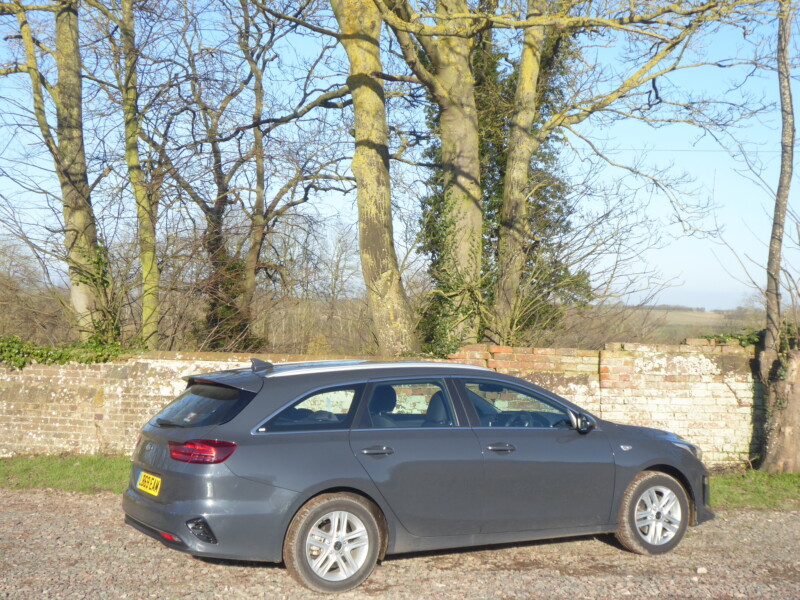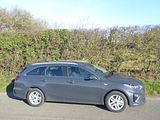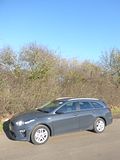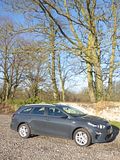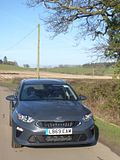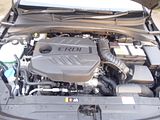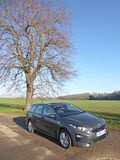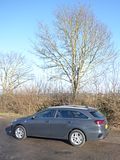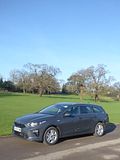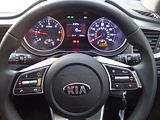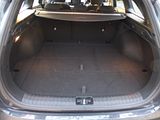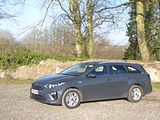The first Kia model arrived in the UK in 1991. Called the Pride, it was essentially a rebadged version of the recently superceded Mazda 121 and was notable more for its whitewall tyres than anything else. But the pundits were all warning everyone to watch out as the Koreans looked very likely to repeat in the next decade what the Japanese had done twenty or thirty years earlier, moving quickly from producers of dependable but not exactly exciting cars (mainly) sold on value to offering us product that retained all the good virtues and added lots else around style and desirability. Sure enough each successive Kia model showed us that this was exactly the direction in which Korea’s automotive number was headed. The second generation Sportage served notice that the company was only a hair’s breath away from producing class-leading products and then in 2007 we got the Cee’d. Designed, engineered and built in Europe – which in itself was an indication of just how serious Kia was about its global scale ambitions, this C-segment hatch really did shock the motoring world and gave its traditional rivals, such as the Ford Focus and VW Golf, a somewhat bloody nose. It ticked every box dynamically, looked smart and up to the minute, was well finished inside and the 7 year warranty was the coup de grace that made this a truly recommendable car. Well over 600,000 customers clearly thought so and duly bought one. Kia’s model cycles are a bit shorter than most other manufacturers so in 2012, just five years after the launch of the first generation car, we got a new one. Better in every respect, it continued the sales progress of its progenitor, and indeed my own experience of both generations of the car were extremely positive. The most surprising thing about the third generation car, which was launched in early 2018, making its public debut at the Geneva Motor Show, was that Kia finally decided to simplify the name and the Cee’d (always said as the “Cee apostrophe Dee” following one Jeremy Clarkson’s lead) became just the Ceed, and the stylish alter ego which had hitherto been a three door coupe and was not a fastback estate became the Proceed, with no silly extra characters to make the correct name difficult to represent. Otherwise, the update brought everything you might expect: new styling that deviates just enough from it is predecessor as to be recognisably new, but not deviating far from what by common consent was one the better looking cars of its type, a higher quality interior, with extra equipment and a whole load of new safety features (some more desirable than others – than you, NCAP!) and extra efficiency to reduce the fiscal and running costs. UK and European sales started in the summer of 2018 and the reviews were pretty positive. It’s taken a couple of years but finally, I’ve managed to get behind the wheel of one, with an estate model, known in proper Kia speak as a SportWagon, was the car that Hertz at LHR allocated to me. It came in that fashionable sort of grey that looks like they forgot got to put the top coat with some colour to it on the car (but plenty seem to think they want this!). Kia call it “Dark Penta”, whatever that means. So whilst the colour was not my choice (there are plenty of more interesting options available!), I wanted to see what the rest of the car was like. Read on.
Just like its predecessor, the Ceed is available with a choice of petrol an diesel engines, Mirroring what is going on across the industry, the petrol engines are smaller capacity units than their predecessors, but with similar output to before. The diesel, of 1.6 litre capacity, slightly surprisingly, given the market move away from this fuel type, is all new. And is referred to as “Smartstream” That is the engine which powered the test car. It generates 113 bhp and more significant, 207 lb/ft torque is available between 1500 rpm and 2750 rpm. It scores highly for refinement, and indeed from a sound and smoothness point of view, it is most un-diesel like. It is probably fair to describe the Ceed as bris rather than fast but for everyday motoring, the power and more importantly, the torque is more than enough to endow the Ceed with good mid-range acceleration, with the official 0 – 60 time coming in just under 10 seconds and with figures which beat all the Kia’s main rivals. To get the best out of it, you do need to use the gears. The test car had the standard 6 speed manual box, an increasing rarity in rental cars even of this type these days. The gearchange is very good, with the lever slotting cleanly and precisely between the ratios. In some markets, Kia offers an optional ECO pack with taller gearing. For UK markets, this feature is standard. That really does mean that sixth is really intended for steady speed on the motorway, a point at which the Ceed is particularly quiet, but for any meaningful acceleration, you will need to come a ratio or two, but this is no real hardship. The high gearing and the fact that I completed most of my test miles at steady speeds on the motorway contributed to excellent fuel economy and I managed to average around 52 mpg during the test.
Kia have worked hard to try to rival the class best in the other driving dynamics, and have undoubtedly got very close Without having sampled the latest Ford Focus, which always used to be the leader here, I can’t be sure how close to the top they have got, but I suspect the answer they have more or less succeeded. The steering is as well judged as you are likely to find in the era of the electrically assisted set-up with some feel to it. The handling holds no surprises in everyday motoring and grip levels are high and there is very little in the way of body roll. Entry level versions of the Ceed, such as this test car come on 205/55 R16 wheels and I would wager that these probably make this the best riding of the Ceed range certainly I found the car comfortable and well able to handle the worst of the less than perfect road surfaces that epitomise Britain in 2020. The brakes are well up to par. I was a little surprised and rather pleased to find that you still get a conventional pull-up handbrake between the seats, as these are fast becoming a real rarity in any car. Visibility is generally good, with the rear-view camera helping the driver to judge where the back end of the Ceed is. A full complement of the latest safety systems and features are included, and as is generally the case, these really are a mixed blessing. The Lane Keep Assist is particularly aggressive, and generally unwelcome in what it tries to do and as is now the case on all the latest cars, whilst you can turn it off, it resets to on every time you restart the car. Forward Brake Assist and Collision Avoidance can also be a mixed blessing but the well-intentioned folk at NCAP have decided that we all need them, so they are standard on every Ceed model.
The interior of the Ceed is particularly nicely finished with a cohesive and unfussy design and a quality of materials that shows that the Audi influence that arrived at Kia a few years ago when Peter Schreyer arrived there from the German brand persists to this day. The main dash moulding and most of the trim is black, but there are some matt grey finishers to provide colour contrast. There is a nice leather-wrapped wheel to hold. A conventional key is still required to start the Ceed. There are two large dials in individual cowls for the main instruments of rev counter and speedometer, with smaller water temperature and fuel level inset in the lower portion of each, respectively. Between them is a digital display area and there are a lot of menu options to select from, depending on what view you wish to see. There are a pair of column stalks with the lights, which include an auto function and auto dip on the left hand one. The steering wheel boss contains cruise control and audio repeater functions. The centre of the dash contains a 7” colour touch screen for the audio unit and various car settings only in this model. Clearly posher Ceeds will have more function here and they get a slightly larger screen. On this one you get DAB radio, Apple Car Play and Android Auto and the system proved particularly easy to use, which is not something that can be said about all such these days. There is a six speaker audio system and sound quality is perfectly acceptable if not the last word in hi-fi. There are still a couple of buttons for the unit but the rest needs to be done with the touch interface. Beneath this are a couple of knobs and an array of buttons for the air conditioning system.
Seat upholstery is a pleasant sort of hard-wearing cloth, as you might expect from the entry level version of a family car. And adjusting the front seats is a manual process, with a bar under the seat for fore/aft and levers on the side for backrest rake and height. The steering wheel telescopes in/out and up/down over a decent range, so it should be possible for drivers of all different sizes to get comfortable. I certainly had no issues in so doing and found that seat comfort was good when sat in the car for a couple of hours, the longest stint in which I was there.
Space in the rear of the Ceed is good, with ample legroom even if the front seats are set well back. Three adults should just about fit across the car and there is no shortage of headroom, an improvement on the previous model as the seats are set lower than had been the case. There is a drop-down armrest which includes cup holders in the upper surface and for those odds and ends, both front seats have map pockets to complement the pockets on the doors.The raison d’etre of an estate car, or SportWagon, to give this one its official name, is to provide more space for luggage, especially of the bulkier sort that night not fit so easily in a regular hatch model. The Kia Ceed does not disappoint as with the seats erect and the load cover in place, there is a generously sized boot which is larger than that of the Golf Estate by a bit and the Focus by quite a bit more. The tailgate opens low and flush with the boot floor so sliding large and heavy items in would be easy and the opening is also nice and wide. There are ample numbers of hooks to help secure things if needed. The rear seat backrests are asymmetrically split and simply drop down onto the backrests to create and a long and flat load area. There is also a useful stowage well under the boot floor. Inside the cabin there is a huge glovebox, some useful bins on the doors and sizeable recess in front of the gearlever and there is an armrest cubby, which should more than suffice for the majority of owners and their passengers.
The Sport Wagon is offered with a choice of two petrol engines, a 120 PS 1.0 Turbo or a larger and more powerful 140 PS 1.4 unit or this 1.6 litre diesel, the last two of these offered with a choice of manual or automatic transmissions. There are now two levels of trim, the First Edition version having had a limited life as was always going to be the case given its name. The entry level trim is known as the 2, and this is hardly one you would call lacking in standard features. The long list includes all this lot: Cruise control with speed limiter, air conditioning, an alarm system, front wiper de-icer, electric windows all-round and automatic headlight control. Other features include 16-inch alloy wheels with locking wheel nuts, front fog lights, projection headlights and cornering lights, electrically adjustable and heated door mirrors in body colour, a high gloss black front grille, chrome window surrounds and LED rear lights. Inside, there’s black premium cloth seat trim, a leather trimmed steering wheel, gearshift and hand brake and a rear centre armrest. A seven-inch touchscreen audio display is provided, along with a reversing camera system with dynamic guidelines, DAB radio, Bluetooth with voice recognition and music streaming Android Auto and Apple CarPlay smartphone compatibility with voice control. Safety includes Lane Keeping Assist (LKA), High Beam Assist (HBA), Driver Attention Warning (DAW), Hill Start Assist Control (HAC) and Forward Collision-Avoidance Assist (FCA). The 3 trim adds 17-inch alloy wheels, privacy glass and rain sensing front wipers, in addition to black cloth seat trim with black faux leather bolsters and power lumbar support for the front seats. An eight-inch touchscreen satellite navigation system with European mapping and traffic messaging channel is provided alongside Kia Connected Services featuring TomTom Live. Other equipment includes dual-zone automatic air conditioning, electrically folding door mirrors with LED indicators and kerbside lights, an auto-dimming rear view mirror and rear parking sensors, in addition to a 4.2-inch supervision colour cluster display, a USB fast charger in the front centre console and a dual-tone horn. The central fascia is in high gloss black, while the interior door handles have a satin chrome finish. Manual gearbox variants have the Forward Collision-Avoidance Assist system (FCA) upgraded to include pedestrian detection. Although no longer available, the First Edition came even better endowed and the spec added the Smart Park Assist System (SPAS) which integrates front and rear parking sensors with the ability to automatically park in parallel or perpendicular spaces, while smart cruise control with stop and go functionality and a Drive Mode Selector are featured when the seven-speed Dual-Clutch Transmission (DCT) is chosen. There’s black leather seats with contrast grey stitching, heated and ventilated front seats, heated outer rear seats and a 10-way power adjustable driver’s seat with memory. A wide electric tilt and slide sunroof with automatic roll blind also comes fitted along with LED bi-function headlights and cornering lights, an electronic parking brake, heated steering wheel, stainless steel pedals, smart entry system with engine start/stop button and an eight-speaker JBL premium sound system with wireless mobile phone charger. Extra safety systems include Blind Spot Collision Warning (BCW), Lane Following Assist (LFA), Speed Limit Information Function (SLIF) and Forward Collision-Avoidance Assist (FCA) with Pedestrian Detection.
I don’t think anyone is ever likely to get particularly about the Ceed, but then that’s not really the point, as this is conceived as practical family transport and with that goal in mind it hits the spot pretty much dead centre. There is really nothing of significance here to dislike or criticise. The Ceed goes well, is decent to drive, is well finished and roomy and even in entry level trim is decently equipped. Kia have built up an excellent reputation for reliability and their customer satisfaction is among the very highest of any brand, a position it has enjoyed for many years now. And just in case anything does go wrong, it still has that industry-leading 7 year warranty. Best car in its class? It very well may be, though until I have driven the latest versions of its major rivals, I can’t be categoric about this, but it really would not surprise me. It’s all a far cry from the Kia Pride of barely 30 years ago and shows just how quickly the determined can advance.

